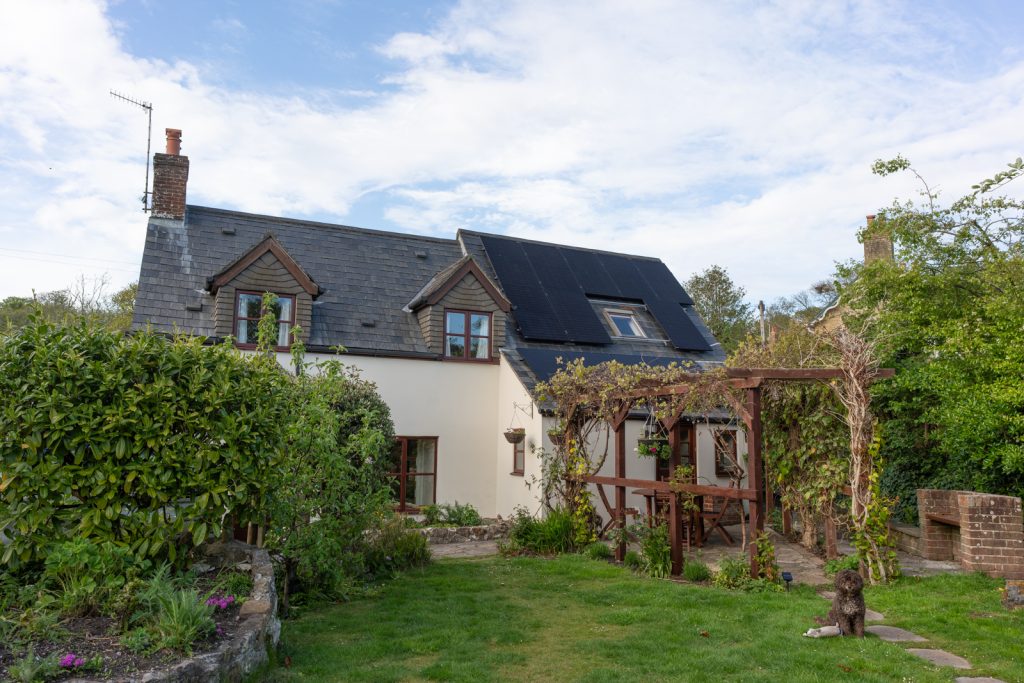One thing we always wanted to have installed when we (finally) found a house was solar power. I know some people hate the way it looks and would never have it because of the aesthetics. Personally I don’t think it looks too bad and the benefits far outweigh the disadvantage of “looks”.

There were lots of things we took in to consideration when deciding which system to opt for and I’ll try and cover each of these in a semi-structured way….
Consumption
It is almost impossible to work out what solar system to go for until you know what your average daily electricity consumption is. Possibly just as important is knowing when in the day you use your power…
We both work from home so we are at home during the peak solar production hours. This also means that I can switch the washing machine and tumble drier on when we are producing most solar.
The first step on our journey was to switch to Octopus Energy (more about this later).
Until we had our smart meter installed I was taking weekly meter readings and popping them in to a spreadsheet. From this I was able to calculate that on average we were using 12.43 kWh of electricity per day. There are two peaks in our day. The first in the morning when the electric shower is running and the second in the evening when I am cooking.
Both of these peaks fall outside the best solar production hours (10am – 4pm).
Batteries or no batteries
For us, with our consumption and usage pattern, batteries seemed a sensible option. This means that we can store the excess solar we produce during the day and use it in the evenings and early mornings.
Working out what capacity batteries was the next challenge. The capacity needs to be big enough to cover the hours outside solar production BUT a) batteries are expensive b) there are other limiting factors….
REMEMBER with most Lithium batteries you can only use 80% of their stated capacity. So, our 7.2 kWh battery pack will only provide us with 5.76 kWh of useable power. This is because if you drain the batteries to 0% they will die pretty quickly.
Limitations
- Inverter Power Output – Inverters have a maximum power they can output. For our inverter this is 3.68 kWh. What this means is that if we are using more than 3.68kWh in the house at any one time the additional power will be drawn from the grid and we will have to pay for it. One example of this is our electric shower. It is a 9kWh shower so when we use it we can use 3.68kWh of our own electricity but we will also be pulling an additional 5.32kWh from the grid.
- Battery charge/discharge rate – If you think of your battery like a water tank being filled from a pipe. You can only fit so much water down the pipe at any one time. The same is true with the electricity. It can only charge or discharge up to a fixed maximum rate. For our batteries this is 2.5 kWh.
- Grid Limitations – Where we live (on the Isle of Wight) there is a limit of approx 4.5kWh on the size of solar installation for domestic premises. This is down to the size of the cables linking the island to the mainland and the capacity they can support (think of pipes and water again !).
So, the main limitation for us was the National Grid. After that it is being sensible about what you actually need and for how long you need it. Whilst our system can’t supply all the power we need to run our shower this is only for a few minutes each day. If you look at the cost of the electricity compared to the cost of the upgraded kit we would have needed it just wasn’t worth it.
Investment
What ever way you look at it solar panels and batteries aren’t cheap so you need to be fairly certain you are not going to move before having them installed.
One thing to remember is that VAT on solar panels is 5%. If you have the batteries installed at the same time as the solar they are also charged at 5% VAT. If you have them installed later you will pay 20% VAT.
While we were having all this work done we also decided to have an electric vehicle charging point fitted even though at that time we didn’t have an electric vehicle. Again, it worked out cheaper to have it all installed at the same time.
The quotes we received all included an estimated annual solar generation value. These calculations are based on data from Sheffield. Because we are a lot further south (on the Isle of Wight !) in theory we should generate more than the estimate but we will only know this over time.
Our total investment in the solar panels (12 of them), batteries (7.2 kWh) and Zappi car charger, scaffolding, cabling work needed, additional bits for the consumer unit etc came in at £9,296.70. Our “breakeven” point calculated was around 10 years but this is without factoring in the savings on the cost of diesel and before the recent price rise that we have seen. For me though it isn’t just about saving money; it is as much about being as self sufficient as possible and doing my bit to reduce my carbon footprint. What this has done though is greatly reduce the impact of the recent price rises on our household income…..
I’ll go in to a bit more detail in future posts about how this all works in practice and how we have been getting on with it
